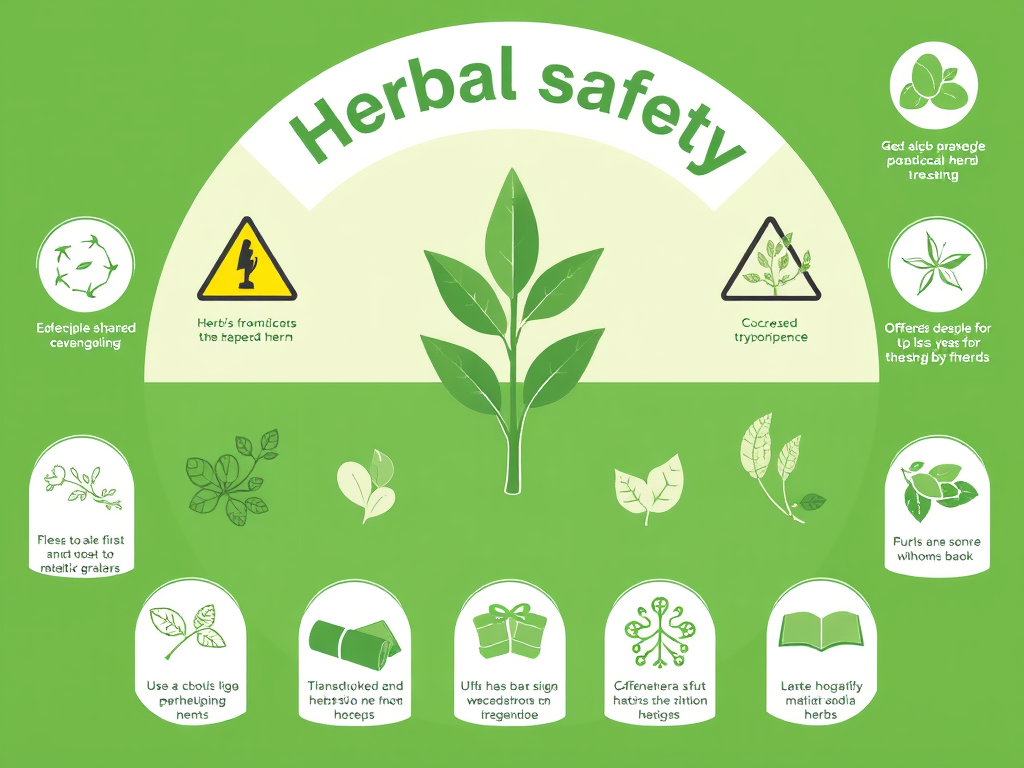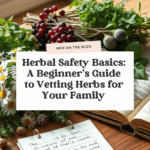Herbal Safety Basics: How to Research and Vet Herbs for Your Family

Herbs are powerful, natural allies — but using them safely is key, especially when it comes to your family’s wellness. Understanding herbal safety is crucial. Whether you’re sipping homemade chamomile tea or reaching for elderberry syrup during cold season, knowing how to research and vet herbs properly builds your confidence and helps you use plants wisely.
This ultimate guide is here to walk you through every step — no overwhelm, no guesswork—just tried-and-true ways to safely explore the world of herbs, one leaf at a time.

Why Herbal Safety Matters
Herbs might be “natural,” but that doesn’t mean they’re risk-free. Many plants contain potent compounds that can interact with medications, trigger allergies, or be inappropriate for children, pregnant women, or individuals with certain conditions.
Knowing how to:
- Understand what an herb does
- Evaluate who it’s safe for
- Learn how to use it properly
…can make all the difference in using herbs with confidence.
Step 1: Start with Trusted Sources
Before you dive into using herbs, you need trustworthy, evidence-based information. Here’s where to begin:
Recommended Books:
- Herbal Recipes for Vibrant Health by Rosemary Gladstar
- Body into Balance by Maria Noël Groves
- Herbal Medicine for Beginners by Katja Swift and Ryn Midura
- The Modern Herbal Dispensatory by Thomas Easley & Steven Horne
Online Databases & Websites:
- Herbal Academy: Reliable herbal courses and monographs
- American Botanical Council: Research-focused herbal safety information
- Henriette’s Herbal Homepage: One of the oldest herbal sites online
- PubMed: Search for clinical studies
Avoid blogs or social media posts that don’t cite sources. Anecdotes can be helpful — but they shouldn’t be your only reference.
Step 2: Learn the Basics of Herb Identification
Don’t guess. Always double-check that the herb you’re using is exactly what you think it is.
- Use both common and Latin names. For example: Lemon Balm (Melissa officinalis), not to be confused with Lemon Verbena.
- Source from reliable herbal shops or growers.
- Never forage unless you’ve been trained. Many plants have dangerous lookalikes.
If you’re buying dried herbs, look for organic, non-irradiated herbs from companies like Mountain Rose Herbs or Starwest Botanicals.
Step 3: Know Who It’s For
Certain herbs are off-limits — or require adjustments — based on the person using them.
Key Considerations:
- Pregnancy & Breastfeeding: Many herbs (like blue cohosh or pennyroyal) are unsafe during pregnancy.
- Children: Stick to gentle herbs like chamomile, lemon balm, or catnip for kids.
- Elderly: Consider medication interactions and sensitivity.
- Autoimmune or Chronic Conditions: Some herbs (like echinacea) may not be appropriate.
Tip: Use reputable herbal safety books like The Essential Guide to Herbal Safety by Mills & Bone.
Step 4: Learn to Read Herbal Monographs
An herbal monograph is like a “profile” of an herb. It includes:
- Botanical name and plant part used
- Actions (e.g., nervine, expectorant, adaptogen)
- Uses and benefits
- Contraindications (when not to use it)
- Interactions
- Dosage & preparation
These are gold when it comes to vetting herbs. The more monographs you read, the more confident you’ll feel.
Step 5: Start Simple with Gentle, Well-Researched Herbs
If you’re brand new to herbs, begin with time-tested, gentle plants like:
| Herb | Use | Notes |
|---|---|---|
| Chamomile | Calming, digestive | Avoid if allergic to ragweed |
| Peppermint | Upset stomach, headaches | Not ideal for young babies |
| Lemon Balm | Uplifting, antiviral | Safe for most people |
| Elderberry | Immune support | Avoid raw berries; not for autoimmune conditions without guidance |
| Calendula | Skin healing | Often used in salves, safe topically |
Stick to single herbs at first so you can observe how your body responds.
Step 6: Understand Dosage and Preparation
Always follow the recommended dosage on your trusted source or product.
- Teas: Steep 1–2 tsp of dried herb per cup. Typically 2–3 cups per day for adults.
- Tinctures: Read label — usually 15–30 drops, 1–3x/day.
- Infused Oils/Salves: External use only.
Tip: Dosage for kids is typically based on weight. Herbalist Clark’s rule is helpful: child’s age ÷ (age + 12) = fraction of adult dose.
Step 7: Keep a Herbal Journal
Track what herbs you try, the form (tea, tincture, etc.), and any reactions or results.
Include:
- Date started
- Reason for use
- Notes on effectiveness
- Any side effects or reactions
This builds your own personalized reference guide!
Step 8: Trust Your Instincts & Go Slow
Herbs are amazing — but there’s no rush. Focus on building your knowledge one plant at a time.
- Start small: One herb, one use, one recipe.
- Stay curious: Ask questions, read, and connect with trusted herbalists.
- Pay attention: Your body knows more than you think.
You don’t need to know everything to begin. You just need to start.
Bonus: Free Herbal Safety Checklist
Want a printable list to help you vet herbs before use?
→ Download the Herbal Safety Quick Checklist from the Freebie Library
This includes:
- Key questions to ask about any herb
- Safe starter herbs
- Red flags to watch for
Final Thoughts
Using herbs can be empowering, nourishing, and deeply grounding — when you do it with intention and care. You don’t need to be an expert or live off-grid to get started. Just be curious, cautious, and committed to learning as you go.
Every cup of tea or spoonful of syrup is an invitation to know your body — and the land — just a little more.


Leave a Reply